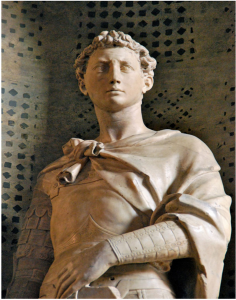 I was spending a college semester abroad in Florence, Italy. That day, we were visiting the Bargello, one of Florence’s great sculpture museums. We made it up to the second floor of the medieval palace and turned the corner into the Donatello room – a feast for any eyes, and especially for those of a college kid studying art history. Yet, almost immediately, my attention was uncannily riveted by a marble figure on the far side of the cavernous space. It was as if that figure was addressing me personally, insistently demanding my full attention.
I was spending a college semester abroad in Florence, Italy. That day, we were visiting the Bargello, one of Florence’s great sculpture museums. We made it up to the second floor of the medieval palace and turned the corner into the Donatello room – a feast for any eyes, and especially for those of a college kid studying art history. Yet, almost immediately, my attention was uncannily riveted by a marble figure on the far side of the cavernous space. It was as if that figure was addressing me personally, insistently demanding my full attention.
As I recall, everything else faded into the background. I turned away from the group tour and stepped through the maze of other sculptures, drawn irresistibly by the force of this sculpture, until I found myself face to face with St. George.
As in all of Donatello’s works, the marble had been superbly molded, so that the skin looked as if it would be soft to the touch. And the marble itself seemed to vanish within the entrancing depiction of the various materials compromising the figure’s clothing and accoutrements. The proportions were effortlessly natural, and the entire composition seemed almost to be breathing. It’s presence was powerful.
But I couldn’t explain the poignant reaction I was having simply by Donatello’s technical mastery. He had captured more, much more. That “more,” whatever it was, pierced me, resonated in the depths of my soul, called out to the very core of my identity.
Who Is St. George?
St. George, the ancient tradition goes, was a Cappadocian officer in the Roman Imperial Guard, raised by his mother in the Christian faith during the period of persecutions. While returning from a successful military campaign in Anatolia (modern day Turkey), he rescued a local King’s daughter from the clutches of some kind of terrible dragon, showing supernatural strength (which he attributed to his faith, not to himself) in his defeat of the monster. Later, he professed his faith boldly before the Emperor Diocletian, who used blandishment and torture to try and make him recant. All to no avail, the saint continued to profess his faith, convert witnesses, and even perform miracles as the persecuting authorities attempted to break his spirit. He finally received the martyr’s crown by being beheaded in the first years of the fourth century.
If you were commissioned by the local Armorer’s Guild to fashion a life-sized figure of such a saint, as Donatello was in 1415, where would you start? How would you depict his heroic virtues of courage, humility, faith, and self-forgetful service? Most artists choose the dramatic encounter with the dragon. But Donatello didn’t. Rather, he chose simply to show the man himself. And that choice made all the difference.
Donatello’s St. George is standing in his armor and cloak, bareheaded, leaning slightly on his shield, the tip of which is touching the ground in front of him. His strength, his youth, his vigor – all these qualities shine forth brilliantly. But something else, some mysterious characteristic, brings them all together and elevates them. That elusive quality, enhanced by the technical perfection and reverential human beauty of the figure, was what struck such a deep chord in my own heart when I first encountered the sculpture.
It took years of reflection and admiration before I was able to put a word to that mysterious quality. But I think I have.
The Power of This Presence
Donatello’s St George is imbued with something that today’s world is in dire need of, something that I too was searching for in those years prior to my conversion to Catholicism: This mesmerizing marble figure embodies passionate and life-giving purpose. This man, standing with this weight forward, poised for action, his head held high, and his gaze intent on the horizon before him, knows what his life is for. He knows where he is going. And that destination is filling him with quiet determination, with unwavering meaning, and also with a dynamic joy that brings an almost other-worldly light to his marble features.
Yes, St. George was a soldier, and he remains a patron saint of soldiers. But he was first and foremost a soldier of Christ, eager to bear witness to his Lord and build Christ’s Kingdom on earth, to the point of risking his reputation, his career, his fortune, and even his very life. This purpose united and elevated his natural gifts and talents to the point that he became a saint. And somehow, Donatello has captured this inner secret and permitted it to penetrate every facet of the sculpture.
This is the power that Christ can give to each and every soul, a true purpose, worthy of the inestimable dignity of every human heart and capable of unifying all the disjointed chards of life in a post-modern world.
The sculpture somehow gave me a taste of that transforming power of Christian purpose, and I began from that moment on to desire a fuller share of it. And the desire sparked by this work of art was so intense that I still consider that encounter as the first step on my path to the priesthood. It was the first inkling of my vocation, the first echo of my call.
St. George, holy martyr of God, pray for all of us to let Christ’s purpose take possession of our hearts!





